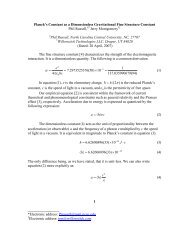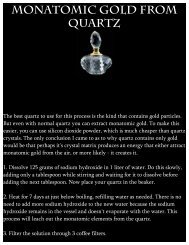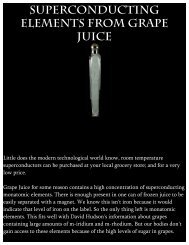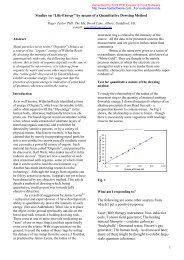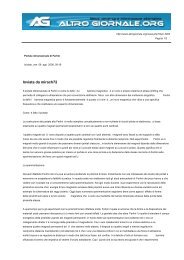Viktor Schauberger
Viktor Schauberger
Viktor Schauberger
Create successful ePaper yourself
Turn your PDF publications into a flip-book with our unique Google optimized e-Paper software.
1942 saw the lightly armed Vril-1-Jaeger flying. It was 11.5m in diameter, was one seated, could<br />
reach supersonic speeds, could do 90 degree turns at full speed, and could leave the atmosphere.<br />
17 copies were built of this model.<br />
A two seated variety was also built.<br />
Around 1940 a jet propulsed saucer version, the V-7 was built. This was a totally different design<br />
by Andreas Epp. This had no magnetic propulsion. Several copies were built.<br />
A combination was the RFZ 7. It had a dual propulsion system, jet motors and a magnetic motor.<br />
It was on this model that Schriever, Habermohl, Miethe and Belluzo were working. The diameter<br />
was 42m, and the prototype was lost on a flight to Spitzbergen. This model was intended to<br />
eventually carry nuclear weapons. The RFZ 7 was unsatisfactory. A second prototype flew<br />
outside Prague. A third prototype was the RFZ 7 T, which was better, but still not performing<br />
well, compared to to the RFZ 2.<br />
A SS-special task force, the SS-E-IV, the development group of the black sun, had the task of<br />
researching alternative energy sources, which did not require the scarce fuel oil. In this group the<br />
magnet motor, and the tachyon converter invented by Hans Coler were developed and combined.<br />
As early as 1939 the first prototype flew with this motor, under the name RFZ 5 or Haunebu I. It<br />
carried a crew of 8, was 25 m diameter, and was supersonic. It had to 6 cm machine-guns type<br />
KSK, and 4 smaller machine-guns type MK 106. It could not fly at high altitudes.<br />
In 1942, a prototype HAUNEBU II was ready. Diameter 30m, it carried a crew of minimum 9,<br />
maximum 20. It was supersonic and could fly 55 hours.<br />
A prototype HAUNEBU III had 71 meter diameter, had a crew of 32, was supersonic, and could<br />
fly for more than 24 hours.<br />
The foo fighters was a general allied name for all saucers. The above mentioned saucers were<br />
rarely observed by allied fliers. What they mainly saw was a small unmanned 'Schildtkrote'<br />
developed by SS-E-IV. This was supposed to interfere with electrical installations in the allied<br />
planes, but was no success.<br />
Another object reported by allied fliers as a foo fighter was the 'Seifenblasen', which was simply<br />
a conventional balloon with metal strips, which was designed to interfere with the allied airborne<br />
radar. The balloons were no success.<br />
Some of the saucer types could travel interplanetarily, and are alleged to have reached Mars. The<br />
first time travel took place in 1944, shortly before the allied conquered Prague. It is rather<br />
unclear what were the results of the time travel experiments. The Americans seemed to do<br />
similar experiments at the same time.



